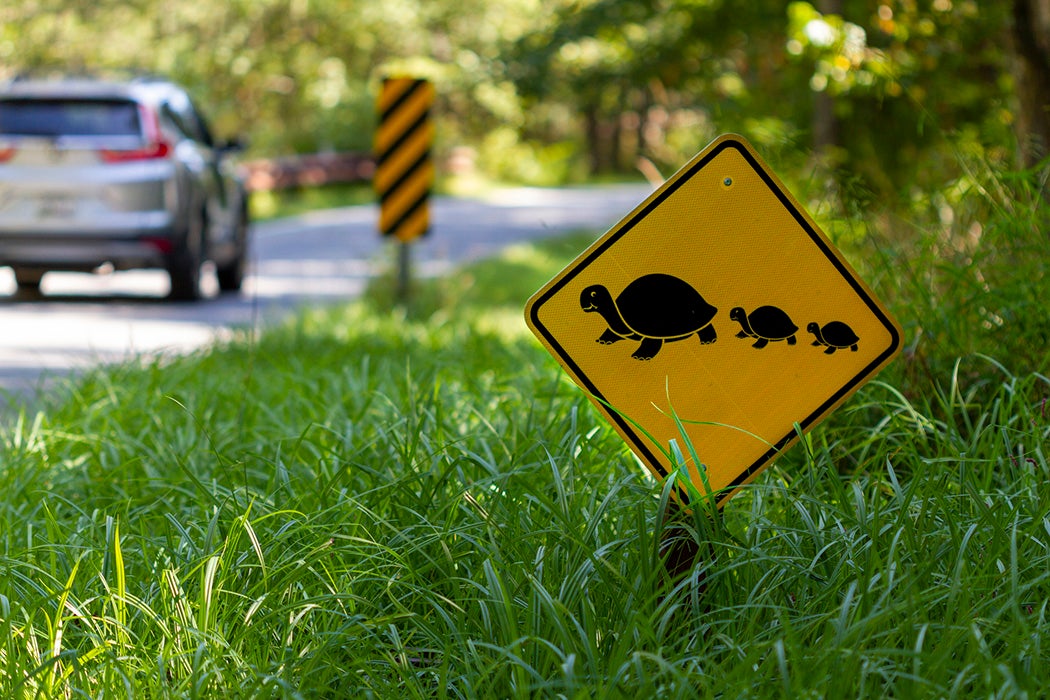According to biologists James P. Gribbs and W. Gregory Shriver, the toll of turtles killed on roads isn’t just grisly, it has real consequences for turtle populations. Apparently, North America’s combination of “exceptionally high turtle diversity” and a lot of roads isn’t a happy one.
Turtles live a relatively long time and have “delayed sexual maturity,” Gribbs and Shriver point out. These factors “severely constrain the ability of turtle populations to cope with additive mortality associated with environmental disturbance.”
The authors note that both land-turtle and pond-turtle species roam during “at least some part of their annual life cycle.” They typically wander daily for food and migrate seasonally, whether to lay eggs or escape from extreme climate conditions. Gravid females, who sometimes travel long distances to lay eggs, are particularly vulnerable.
Losing such sexually mature individuals to drivers is one reason why almost every state has at least one turtle species on its threatened or endangered species list. Once-common box turtles, for instance, are now rarely seen.
Long-term studies have shown that “as little as 2–3% additive mortality is likely more than most turtle species can absorb and still maintain positive population growth,” according to Gibbs and Shriver.
The researchers’ computer modeling shows that road mortality exceeds sustainable levels. In other words, too many turtles are being killed, especially ones that have the ability to reproduce, to the point where deaths outpace births.
Biologist David A. Steen teamed up with Gibbs to conduct field studies to see if turtle population structures were affected by the density of roads surrounding freshwater wetlands habitats. Their biggest finding: a very skewed sex ratio.
Steen and Gibbs surveyed snapping and painted turtles in thirty-five wetlands near Syracuse, New York. They found more males than females in wetlands surrounded by high-density roads than in wetlands surrounded by low-density roads.
For both painted and snapping turtles, embryonic sex determination is temperature-dependent. Warmer nest temperatures mean more females; cooler nest temperatures mean more males. In addition, some agricultural chemicals can influence sex determination because they feminize embryos. With a warming climate and the ubiquity of chemical agriculture, there should be more females than males. But Steen and Gibbs found that 95 percent of the snapping turtles and 74 percent of the painted turtles in the study areas were male.
Since turtles “may persist for decades before the response to disturbance is discernible in populations,” they write, the results of the sex-ratio imbalance may not be known for years.
But the imbalance may become even more skewed. “Many of the roads we incorporated into our study were constructed within the last 30 years, and given the long lives of turtles it is unlikely the effects of roads on turtle populations have been fully manifested over this period.”
Weekly Newsletter
So what can be done about road mortality? Turtles have successfully been blocked from roads by temporary fencing. They’ve been funneled through culverts and other wildlife corridors. Speed reductions and road closures, which work during salamander and frog migration seasons, are other options.
Notably, turtle crossing signs for humans to obey, at least according to one study, result in no significant decrease in the amount of roadkill.







